People that bike, walk (or roll, in the case of wheelchair and electric scooter users) share sidewalks every day, and the combination of modes can cause conflict and confusion. Oregon law, however, is very clear on right-of-way and the legal conduct required when you are bicycling on the sidewalk.
Legal clarity aside, the devil is in the details.
One problem is that bicycle operators travel much faster than walkers and require considerably greater distance to turn and stop. When bicycle traffic is constricted, such as on bridges and other multi-use paths, the inevitable congestion magnifies the impact of the small steering or control mistakes that lead to occasional collisions.
Historically, many villages and cities have identified areas with the highest density of walkers and declared them off limits to bicycling. In Portland, bicycling on the sidewalk is prohibited in the area within SW Jefferson Street, Naito Parkway, NW Hoyt Street and 13th Avenue (except in the Park Blocks, on bridges and multi-use paths). However there are no warning signs to define these boundaries, and (as a result) an almost universal ignorance and disregard of the law. This creates an uncertain environment for everyone that guarantees selective and uneven enforcement.
While New York City prohibits biking on sidewalks for people over 14 years of age, a more recent law includes a “pedestrian-endangerment” provision carrying a $300.00 fine or 20 days in jail and bike impoundment. Physical contact with someone walking on the sidewalk results in a $600.00 fine or 20 days imprisonment and bike impoundment. While protecting people is a laudable goal, in an average year in New York City (2011 population 8.2 million), bicycling on sidewalks resulted in zero deaths and fewer than 200 injuries to people walking. In the same average year motor vehicle operators kill 200 walkers and injure 11,000 of them. Clearly, the safety hazard associated with bicycling on sidewalks is more of an annoyance than a high-level, life-threatening risk, at least when compared to other hazards.
The law is clear
The law is clear that people who are walking have the right of way on sidewalks and people on bikes must provide an audible signal when they pass. To obtain the same right-of-way privileges while on your bike (with respect to motor vehicle operators) as you get while walking, you are limited by the Oregon Vehicle Code to “no greater than a walking speed” — but that mandate only applies when entering driveways or entryways and on crosswalks where there is oncoming motor vehicle traffic. And of course, walkers also have the right-of-way over any other road user when they are in marked or unmarked crosswalks and on sidewalks.
One problem area is that people riding bikes on the roadway sometimes fail to yield to sidewalk users attempting to cross the in marked and unmarked crosswalks. ORS 811.020 prohibits passing another vehicle who has stopped to allow someone to cross, but bicycle operators frequently disregard this provision (to the consternation of other road users). Further, bicycle riders sometimes act as if they believe they are on a higher moral plane than other vehicle users and therefore do not really have to stop for people in crosswalks. Other riders demonstrate their trick riding skills by weaving around clusters of alarmed walkers. The Oregon Vehicle Code prohibits such behavior. ORS 814.410, “Unsafe Operation of Bicycle On Sidewalk,” is violated if a person “[O]perates a bicycle on a sidewalk in a careless manner that endangers or would be likely to endanger any person or property,” creating an offense with similar operational language to the better known “Careless Driving offense”.
In conclusion, when the rules are followed, sidewalk bicycle riding can be safe. However, riders sometimes save their worst behavior for the sidewalks and ignore the laws that regulate their use. When people are aware of the laws — and more important when the follow them — the whole mix goes a lot more smoothly and the sidewalk can provide an important artery for non-motorized travel.
(Note: This guest post was edited to reflect our editorial guidelines.)

(Photo © J. Maus/BikePortland)
This article is part of our monthly legal series with Portland-based lawyer and bike law expert Ray Thomas of Swanson, Thomas, Coon & Newton. (Disclaimer: STC&N is a BikePortland advertiser and this monthly article is part of our promotional partnership.)

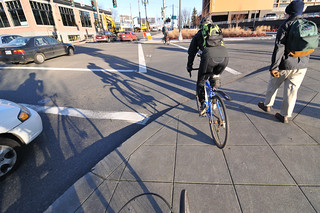
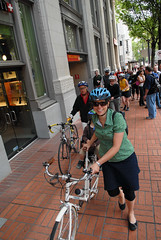
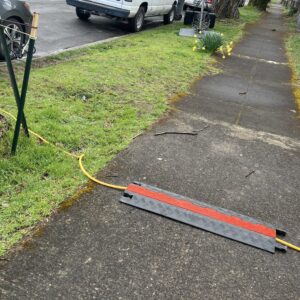
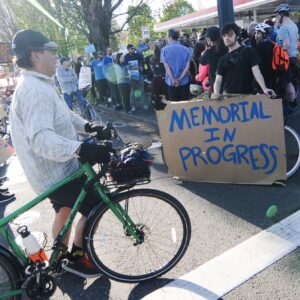
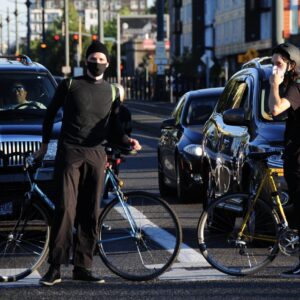

Thanks for reading.
BikePortland has served this community with independent community journalism since 2005. We rely on subscriptions from readers like you to survive. Your financial support is vital in keeping this valuable resource alive and well.
Please subscribe today to strengthen and expand our work.
Regarding New York’s bike impoundment law – no criminality for Francis Aung Lu, who steered his SUV onto a sidewalk and crushed three middle school girls.
Note to readers… I’d love feedback on how this article came out. I did considerable editing to scrub out all uses of the terms “bicyclist” and “pedestrian”. (No offense to Mr. Thomas, this is largely a style issue after all.)
Given that, I’d love to hear feedback on how the article reads. Did you even notice anything different?
I really have no idea why “bicycle operators” and “walkers” is better than “cyclists” and “pedestrians.” I get the sense you feel people shouldn’t be labeled by their transportation mode, but when we’re simply talking about modes and comparing them, it seems entirely appropriate to me. Is it a concern that talking about “drivers” and “cyclists” creates a big divide between the groups? I don’t mind being called a “developer” when I’m working on Web sites, and a “brewer” when I’m making beer in the back yard, so I’m not sure what’s wrong with the same usage in the transportation realm.
The constructs you’re using feel cumbersome and get in the way of the story, to my ear, and I don’t see any real advantage to them. Just my two cents! To answer your question, I do see some typos in the article, but I don’t know if they were introduced during your editing or not.
It feels a little too “forced PC” to me.
It reads fine to me. I appreciate your (JM) use of humanizing terms to reduce divisiveness and conflict, and your pieces read fine to me, too, with your terms in your voice. Ray’s balanced and informative pieces about the law tend to de-politicize mode issues into abstract legal terms anyway, so allowing him to write in his voice works for me. It’s a step in reclaiming ‘bicyclist’ as a useful word, too.
Agreed. I wasn’t aware that you were avoiding the terms “bicyclist” or “pedestrian” for this article. I thought the article was informative, and easily read.
That’s a very good point Alan. But I erred on the side of doing the editing because of how blogs are read. What I mean is that, with just one column of stories and small bylines, I think it’s hard for people to really understand that someone else is writing the story. Not only that, but most people assume I write everything (although that’s changing with the regular publication of Michael’s stories).
That being said, point taken.
Then there is the issue of your preferred verbiage (it’s growing on me but is situationally cumbersome) versus the specific verbiage used in the law itself.
If the law is specifically saying “cyclist” and “pedestrian” we shouldn’t change those in a story just for perception’s sake. If there is divisive language in our legal code we need to be aware of it lest we continue to allow lawmakers to live in the insular world constructed from their damaging words.
If I am waiting at a red light in a left turn lane, and I am on my bike, and the light for the cross street and pedestrian signal turns green/walk sign, is there anything preventing me from using the crosswalk to access the sidewalk on my bike? (assuming I am out of the restricted area downtown)
Not a legal expert at all but:
I don’t think there would be a problem as long as you don’t have to cross the intersection to access the crosswalk (mostly likely marked in this situation). Probably not if crossing is prohibited on your side of the intersection.
Though personally (I’d would wait in your described situation) if I’m in an auto lane, I ride mostly by auto rules – and unless there is a bike lane – will take a lane (there is almost always something nearby to blame for avoiding riding all the way to the right). If I’m on a sidewalk I ride mostly by pedestrian rules, where walkers get the right of way. And under most circumstances I prefer to ride in traffic than on the sidewalks where it is statistically much safer.
thanks
I know and appreciate what the law says, but I can think of a few places where it pretty much sucks, especially in that Portland zone.
Take any one-way street, lined with parked cars and a high sidewalk, where your destination is mid-block. Let’s just say I’m not inclined to get in and out of there by dismounting at one intersection and pushing all the way to the next.
Unless the sidewalk is crowded, I usually compromise by riding my bike at a walking speed to my destination. My office is in the middle of the block, so this comes up a lot. Sometimes I’ll use my bike as a skateboard: put my right foot on the left pedal, and then kick the sidewalk with my left foot to move forward. I’m not straddling the bike, so it’s legal on downtown sidewalks, right?
I don’t think skateboards are legal in the downtown core either on the sidewalk.
” And of course, walkers also have the right-of-way over any other road user whey in marked or unmarked crosswalks and on sidewalks.”
You mean … user “when in” or “when they are in” marked …
Gosh, I hope he doesn’t mean the liquid left over after the road user is churned!
Meant “when they are in”. thanks for catching that Joseph E.
Good stuff to know, I use the sidewalks all the time. Kinda have to on streets like Powell and parts of Foster. I got no problem walking half a block where heavy pedestrian traffic occurs when my destination is mid block (parts of Downtown and Hawthorn mostly)
But I do gotta wonder unless you actually hit a pedestrian or cause property damage is seems to me that http://www.oregonlaws.org/ors/814.410 would be hard to prosecute, since riding dangerously is kind of a judgment call, and a more experienced rider can easily pull off maneuvers that lesser experienced riders and onlookers would say look dangerous than they actually are .
For reference, here is a map of the area of downtown Portland where sidewalk riding is prohibited:
https://mapsengine.google.com/map/edit?mid=z63l2xapyReA.ktdlXbdpH9bg
Note that the PSU area, parts of the Pearl, and everything west of 405 are ok for bikes.
This seems like a good spot to ask something I’ve been wondering for a while…
Does anyone know what the 2 block section of Yamhill between 3rd and 1st qualifies as in regards to a street/Sidewalk? Is it really legal to ride there? I do pretty much every day as I’m leaving work.
I’d guess its one of those grey areas. TriMet might hassle you and tag you with interfering with the transit system like they do with jaywalkers up at Civic Stadium (yes I hold on to the old name….) I imagine its technically closed to vehicle traffic and then you’d have to argue about what the bike is – a vehicle in a closed area or a bike on a sidewalk.
“In Portland, bicycling is prohibited in the area within SW Jefferson Street, Naito Parkway, NW Hoyt Street and 13th Avenue (except in the Park Blocks, on bridges and multi-use paths).”
Did you mean to say that riding on sidewalks is prohibited within these boundaries or that riding a bike anywhere within these areas is prohibited?
yes I did mean to say “on sidewalks”. Thanks. Corrected.
Jonathan, I thought the edited piece read perfectly smoothly & none of the terms seemed awkward to me.
I find this topic and comments interesting. When I’m walking on a sidewalk, I feel threatened by people riding bikes, and I wish it was prohibited everywhere where there is a concentration of people walking. This is probably magnified by the fact that I am often accompanied by a very vulnerable and unpredictable toddler and fear for his safety in these situations. I think it is the courteous thing for bikers to do, regardless of the law, to dismount and preserve a safe environment for walking. I agree that walking half a block feels endless after I have been rolling pleasantly for miles on my bike, but it is really not that big a deal in the grand scheme of things, just like the time I lose waiting at stoplights, or waiting for the elevator in my office building, or putting on all my bike gear before my ride, or whatever.
I agree with you! I hate bikes on the sidewalk, but I ride on the sidewalk along MLK daily to cross 84. I hope that bikes are not banned from sidewalks until traffic speeds and distracted driving is reigned in enough that bikes can be on the road where they belong!
I ride on sidewalks in the legally allowed areas whenever there’s a high density of cars, or unpredictable pullouts from cars parked on the street. Hawthorne Blvd is a good example; too easy to get hit by random bad luck and too many variables to watch out for. I just don’t trust drivers to be paying attention 100%.
It’s the same reason walkers use the sidewalk; they like some sort of physical barrier between them and traffic, and cyclists’ lives are no less important, eh?
But I still get random glares, typically from women (and sometimes yelled at) when I ride on sidewalks, even though I try to ride slowly and carefully around people. They seem to think cyclists don’t have full control over their bikes. Maybe reckless teens and other riders have given it a bad reputation by going too fast and weaving around people, which spooks them. I do use the street (even in car-dense zones) if pedestrians seem too numerous on the sidewalk.
For the most part, the only people I see riding on sidewalks downtown are private security dressed up like cops. What are the laws regarding the privileges of both police and civilian hired security? As I understand, police officers can “break the law” when heading towards an emergency, but I never heard of anybody having the right to do “rounds”.
police and security companies are exempted from the sidewalk ban…
Here’s a link that addresses the question above:
http://bikeportland.org/2007/01/23/guest-post-why-cops-ride-on-sidewalks-2886
Thank you for the response, PoPo, that surely clarified the issue re: officers on the sidewalk. I’m still unsure about the privilege given to private contractors, even though I might understand why they believe it’s better for them to ride on the sidewalk.
from the city code cited in the PoPo link —
except: …
5. For employees of the Association for Portland Progress and companies providing security services operating a bicycle in the course and scope of their duties. These employees must have in possession an identification card issued by the Chief of Police certifying the rider has completed a training course in the use of a bicycle for security patrol.
http://www.portlandonline.com/auditor/index.cfm?c=28596#cid_16278
You can ask the rent a cops if they have an ID card. I wonder if any do?
I’ve found nothing quite as fun while sidewalk riding as performing a perfectly motionless track stand suddenly. Not to make people run in to me from behind (happen more than once) but to see their stunned faces when they realize they are passing you.
If they can stop to window shop so can I.
Thank you, this is a VERY helpful article. Bicycles can transport us long distances where Portland or even Oregon law doesn’t apply. So, what about Vancouver and riding a bicycle on the sidewalk?
I’d like to see ORS 814.070 Improper position upon or improperly proceeding along highway;, the pedestrian statute, covered in detail.
It’s tiring having to deal with runners using bike lanes when the law requires them to use sidewalks when present. There’s plenty of encroaching on bike infrastructure by both drivers and pedestrians.
Fixies are easily ridden at walking speed.
The article does not adequately address the safety of sidewalk riding. Generally it is not safe or even safer than being on the road: http://www.bike.cornell.edu/pdfs/Sidewalk_biking_FAQ.pdf
I ride on a sidewalk only for short distances when there is no better alternative.
I found this piece difficult to parse. I thought it was going to be a “know your rights” piece but came across more as opinion, both in it’s structure and sentiment. Statements like this really mucked it up for me:
Further, bicycle riders sometimes act as if they believe they are on a higher moral plane than other vehicle users and therefore do not really have to stop for people in crosswalks.
If I’m reading a legal advice article, I’d much prefer succinct bullet points on what I can/can’t do, perhaps with reasoning/context stated separately.
Here’s another example of a sentence I struggled with:
To obtain the same right-of-way privileges while on your bike (with respect to motor vehicle operators) as you get while walking, you are limited by the Oregon Vehicle Code to “no greater than a walking speed” — but that mandate only applies when entering driveways or entryways and on crosswalks where there is oncoming motor vehicle traffic.
Maybe I’m dumber than the average bear but that would be a hell of a lot easier to read as two sentences. Also, the parentheses seem to de-emphasize a point that is integral to the statement and had me wondering what I was missing.
How about
“Further, bicycle riders sometimes act as if they believe they not nearly as much of a hazard to pedestrians than motorized vehicle users and therefore do not really have to stop for people in crosswalks.”
I suspect most bicyclists that almost run me over when I’m using the crosswalk at Williams and Beech or Williams and Failing aren’t thinking about moral superiority over cars, but just that they can squiggle through a line of pedestrians with relative ease, whereas a car blasting through would put everyone’s lives at risk. Physics, not Ethics.
Ted Buehler
Yeah, this is an op-ed not a legal discussion. The foray into values and morals was unnecessary and shocking.
Jonathan and kittens,
It’s just Ray. This is his writing style. It is both an op-ed and a legal discussion.
My big question remains unanswered. I sum this law up for people like this:
If you are riding on a sidewalk where it is allowed (outside the Portland downtown exclusion zone), then you must:
* Yield to all pedestrians
* Give pedestrians an audible before passing them
* Slow to a walking pace when approaching motor crossings (driveways, intersecting streets) and motor vehicles are present, otherwise there are no speed restrictions.
I usually have to explain this to folks who claim that one must always ride at a “walking pace” on sidewalks and…in crosswalks, or else forfeit your right-of-way.
However, the law states you are in violation if you:
I can understand the requirement to approach or enter motor crossings at a walking pace, since poor motorists only look where they expect to see things, rather than where things might actually be, but once in such a crossing, in plain view of even the minimally attentive motorist, the law does not appear to dictate that a cyclist maintain the same “walking pace” at which they were required to approach the crossing–at least with regard to crosswalks (it does say “approaching or crossing” driveways).
My specific question pertains to crosswalks, since there is one particular place where a MUP becomes a crosswalk that I use almost daily. I fastidiously and artificially maintain a low-speed approach to this crosswalk because drivers at this particular location notoriously and flagrantly violate all laws of pedestrian/cyclist right-of-way with striking regularity. However, once I have entered the crosswalk, I boogie right across as it is a long one (the countdown on the pedestrian signal starts at 30 seconds, IIRC). If I am going 8-10mph after entering at 3mph, and some bozo plows into the crosswalk without stopping/yielding appropriately and hits me, do I really have no hope of the driver being held responsible because I didn’t maintain a 3mph “walking pace” all…the…way…across…this…eighty…foot…wide…cross…walk?
I might be missing something, but as I read it once you’ve left the curb you can legally go as fast as you can in the crosswalk. The walking speed rules seems only to apply to the approach and not to the actual crossing of crosswalks.
Yeah, I know, right? BUT then there are quotes like this from lawyers (emphasis mine):
The wording in this quote seems to indicate the opposite of what is written in the ORS, which says “…approaching or crossing a driveway” and “…entering a crosswalk”. The quote states “…entering driveways and ON crosswalks”. I guess it depends on what “on” means.
On principle, it drives me nuts that I have to even be concerned about such nuances of traffic law. If I rear-end somebody in my car, it doesn’t make a difference how fast they were going; it’s my fault. If I run a two-way stop sign and T-bone a vehicle in cross traffic, it doesn’t matter whether they were going 5mph above or below the speed limit. Why is there this implied threat that if a driver blows into a crosswalk without stopping first and hits me, it will be my fault if I was going 8mph instead of 3mph? Isn’t it clearly the driver’s failure to stop before a clearly marked crosswalk?
Why doesn’t anyone seem to know that cyclists… at walking speed, as they approach… have the same rights as pedestrians at crosswalks? If you are waiting at a crosswalk, marked or unmarked, and you are on your bike proper… Forgeddaboutit! TriMet, CoP, nobody stops if you are on the bike. I’d like to hand out tickets to all the two motorcycle police officers in the Ladd’s area who took my pedestrian right of way two weeks ago. In the line of duty. Ironic.
It’s the law. We’re there, pedestrianed and clearly intending to cross… No stop. Never.
Now… step off the bike… and yes, the lady in the Camry will initiate a lemming-like stop sequence for all of traffic.
Obviously it makes people feel better to stop for someone on foot. I push the limit and hop back on my bike and ride through when I get a yielding vehicle.
While legally correct, the statement “Further, bicycle riders sometimes act as if they believe they are on a higher moral plane than other vehicle users and therefore do not really have to stop for people in crosswalks.” is inflammatory and non-contributory.
Additionally, cyclists are by no means the only group who do this. I have had motorists honk and me and give me the finger for standing at the edge of marked crosswalks, attempting to cross the street. Motorists stopping at unmarked crosswalks (as required be law) is almost completely nonexistent.
Thankyou all for the comments. In particular I appreciate (and am a little humbled by) the correction of the paragraph where I attempted to describe this section of the statute prohibition:”Operates the bicycle at a speed greater than an ordinary walk when approaching or entering a crosswalk, approaching or crossing a driveway or crossing a curb cut or pedestrian ramp and a motor vehicle is approaching the crosswalk, driveway, curb cut or pedestrian ramp. This paragraph does not require reduced speeds for bicycles at places on sidewalks or other pedestrian ways other than places where the path for pedestrians or bicycle traffic approaches or crosses that for motor vehicle traffic.”
El bicyclero and Jonathan Gordon make good points. ORS 814.410 ONLY requires the rider to slow to an “ordinary walking speed” when APPROACHING OR ENTERING the crosswalk AND a motor vehicle is approaching. I will correct it in the online version of the article in Pedal Power on our website at stc-law.com. Now I am interested to offer up some more of my legal commentary as I received more and better criticism from the posting in bikeportland than in the several years the article has been on our website.
The comment about the “higher moral ground” was intended not as a jab at our two wheeled community but as an editorial comment on why we (including me for those of you who have ridden with me) sometimes allow ourselves to dispense with the legal requirements that cover us as vehicles. Maybe I should have limited the comment to my own behavior as I do feel sometimes like my narrow width of track and mutant capacity to be both a bicycle and a pedestrian coupled with the fact that I do not have a steel exoskeleton gives me a pass to ignore what i know are the legal requirements.
Thanks for your efforts, Ray. It’s often easier to criticize than it is to create and I appreciate the time and energy it must have taken to write this piece. I look forward to reading more from you in the future.
While I am aware of the law restricting bicycles from sidewalks in the downtown core, I frequently ride the half-block length between the nearest curb ramp and the door to my downtown destination. My logic is that the path between the curb ramp and the door is the closest thing I have to a driveway. Motorized vehicles are not permitted on the sidewalk either, but they effectively travel on it briefly as they enter a driveway. I can’t rationalize bikes not being afforded the same courtesy (provided they yield to pedestrians and travel at a walking speed.)
I’m not sure that those charged with enforcing the law would agree with my rationalization, but I assume there must be some relevant exception in the minds of the bicycle-mounted patrols that can sometimes be seen riding on the sidewalks downtown themselves.